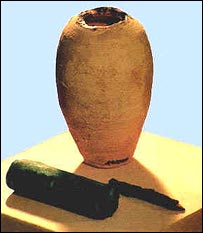When I first came across detail of these items in various articles they spoke assuredly of their being batteries from Baghdad, about 250 BC – 225 AD, a period known as Parthian era. It was said that they were would have been used for electroplating. As a form of technology at such a time, that indeed would be very impressive. Scientists were apparently confirming the age of the vases and their function as batteries. They are clay vases inside of which is a copper cylinder and inside the cylinder is an iron bar protruding a stopper made of asphalt. They are just 5 inches tall (13cm). Apparently such a vessel showed signs of corrosion, and early tests revealed that an acidic agent, such as vinegar or wine had been present.
 It turns out that nobody really knows for sure what their purpose was or even their exact age. Accounts about these batteries are in fact varied and inconclusive. It has been commented, for example, how the artistic nature of the pots suggests they are from a different and younger era altogether, the work of the Sassanian People, who lived from 250 AD – 650 AD. Never the less, this would still be an impressive age in the past at which to be designing batteries.
It turns out that nobody really knows for sure what their purpose was or even their exact age. Accounts about these batteries are in fact varied and inconclusive. It has been commented, for example, how the artistic nature of the pots suggests they are from a different and younger era altogether, the work of the Sassanian People, who lived from 250 AD – 650 AD. Never the less, this would still be an impressive age in the past at which to be designing batteries.
Reading further I find that there is some mistrust occurring for the person who first brought the ‘batteries’ to our attention, a German archeologist Wilhelm Konig. It seems no longer certain as to whether he actually unearthed the clay vases while during an archeological dig at Khujut Rabu in 1938 or found them in the basement of the Baghdad museum when he took over as its director. It is not even certain how many of these ‘batteries’ exist, perhaps twelve is cited. It was Konig who originally put forward the idea that they were batteries, but that was just a guess.
Replicas have been produced and experiments have found that a voltage from 0.8 to nearly two volts can be produced. There are accounts also of Dr Arne Eggebrecht in the late seventies connecting several replicas of the ‘batteries’ together using grape juice as an electrolyte and he claimed to have deposited a thin layer of silver on to another surface, just one ten thousandth of a millimetre thick. Other researchers dispute theses findings on account of a lack of documentation that ought to have accompanied these experiments but which hasn’t been produced. There are no photographs either to provide evidence of the work. Anyhow, it is not so much the voltage as the current produced that is the important, limiting factor in the process and it is doubted that even several these batteries together could have produced the power necessary. It has also been pointed out for comparison that merely sticking a probe into a lemon provides a greater electrical current than one of these clay vases, and that would be a much cheaper method to achieve a result.
Perhaps disappointingly, it is to be accepted that they were never batteries as such, after all, no wires have been found to accompany them. Subsequently, other interpretations have been mustered, such as their usage for medicinal and healing purposes, or trickery associated with religious statues to impress the gullible with a charge of some kind when touched?
So how did they work and how were they used?
I came upon the website of an archeologist who refers to herself as ‘ArchyFantasies’. It’s her domain name also. She writes to debunk bad archeology and pseudo-science. Her comment and reflection of the context surrounding these ‘batteries’ caught my attention because I find it quite credible, in a way. She surmises that the vases were used to store scrolls. I like that, its sensible, simple and grounds any sense of mystery. The alternative is to view the clay vases as something quite incredible, which is the impression so often otherwise painted of them. Even so, it may yet be difficult to rule out entirely the idea that their purpose was not so straightforward. The choice of a copper cylinder and a iron bar does remain intriguing and the shape of the vase, or jar, itself is curious if storing a scroll was its intended purpose. It would be a very small scroll housed inside. The scroll jars housing the dead sea scrolls, for example, were more cylindrical. Perhaps, jars already made for other purposes, wine, vinegar etc., were brought into use to store the small scrolls.
Whatever they are, batteries or not, they certainly are curious items for sure.
Photo Credit: Source unknown